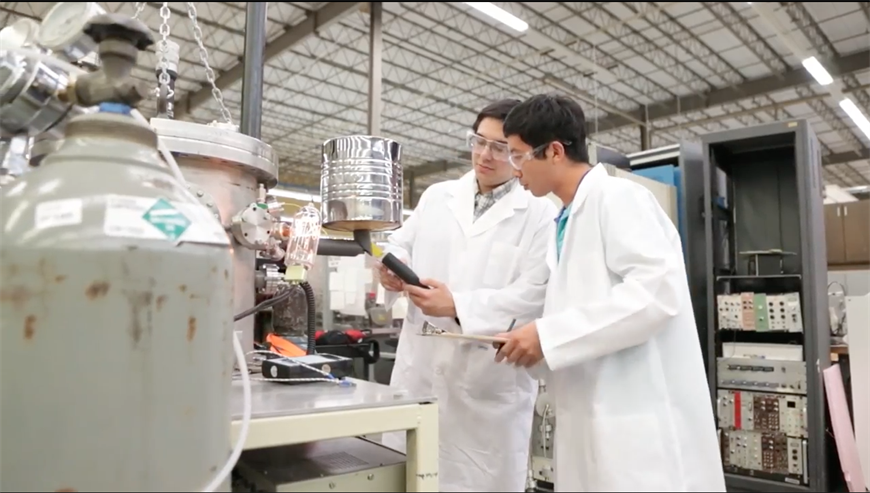Metals travel forward in time at the Ion Accelerator Laboratory, a facility within Texas A&M University’s Department of Nuclear Engineering where researchers within the department’s Ion Beam Laboratory group are speeding up the clock on metallic alloys and steels.
The researchers are using ions as surrogates for neutron radiation to see in a short amount of time how stable these metals are after they endure conditions from decades of use inside a nuclear reactor.
“We're essentially taking these alloys and irradiating with ions to achieve damage seen in reactor-like conditions,” said Jonathan Gigax, a graduate assistant researcher who works under the lab’s principal investigator, Associate Professor Dr. Lin Shao. “This is important because in current reactor facilities it takes decades to get to the levels of wear and tear that these metals will see in next generation reactors. So we use ion accelerators because they can reach it much faster.”
According to Gigax, there are a number of differences between ion and neutron irradiations that prevent one-to-one comparisons. However, numerous early studies and recent studies show that certain behaviors are very similar in both environments. This helps qualify the technique and allows researchers to quickly screen a large number of candidate alloys. The results provide an understanding of the unique properties that make certain alloys radiation resistant so that new alloys can be developed for use in reactor construction and help achieve efficient use of the reactor’s fuel. To achieve optimum efficiency the reactor has to operate at a high burnup, which places stress on the metals and alloys within the reactor. To achieve highly efficient fuel burnups, alloys that can resist microstructural changes from damage produced neutron radiation, also known as creep and swelling, are necessary to ensure a long working life for the reactor.
“A good example of creep phenomena would be a filament in an incandescent light bulb,” Gigax said. “The filament remains at a very high temperature for a long period of time and slowly deforms until it breaks. The same thing can happen with steels at high temperatures or under large stresses, so the idea was that we needed to develop an alloy that does not exhibit creep to a large extent.”
The steels used in the reactor, as a result of creep and swelling, undergo deformation and change the operating behavior of the reactor. Single crystal metals are resistant to creep but are expensive to make and typically exhibit more void swelling than polycrystalline counterparts. Very small grains offer better swelling resistance but make the steel susceptible to creep.

Gigax compares the phenomena to sand in an hourglass, where the grains of sand are very fine and able to flow from one end of the hourglass to the other. Metals that have small grains are more susceptible to creep because the grains are able to more easily move at high temperatures and under stress, especially while being bombarded by neutrons, as opposed to larger grains that offer more resistance. To solve this problem, oxides can be alloyed into the metal to pin those boundaries in and make the movement of these grains more difficult, while retaining the benefits of a fine grain structure with respect to void swelling. According to Gigax, this would be akin to pinning some grains of sand in place within the hourglass, preventing the grains from moving.
“Once you get all these results, there are two things we can do,” Gigax said. “We can look at what makes one alloy better than the others and then guide the further development of that alloy based on its positive qualities, or once you identify a good alloy you can dedicate resources to having that put inside a nuclear reactor to test it in the exact conditions.”
Through the usage of the ion accelerators, the time and cost commitment for reactor testing is dramatically reduced, allowing the research to advance efficiently. In addition to ensuring a longer working life and durability of these reactor materials, these applications also have benefits for the consumer.
“We are contributing to the energy needs of the nation,” Gigax said. “By contributing to the development of materials that can take the added radiation stress of operating at higher, more efficient fuel burnups, which translates to more energy output per source of fuel, we’re helping make cheaper and more accessible energy for the average consumer.”
The research is funded by the U.S. Department of Energy, whose interest in this project leaves Gigax with the feeling he and others on the research team are doing positive work that is benefitting the larger community.
“A lot of our funding comes from government sources,” Gigax said. “The whole idea here is that by getting funded through these projects we are very service minded towards the interests of the community and that couples nicely to the Aggie Spirit. As Aggies, it’s good to feel like we are serving the interests of the community.”